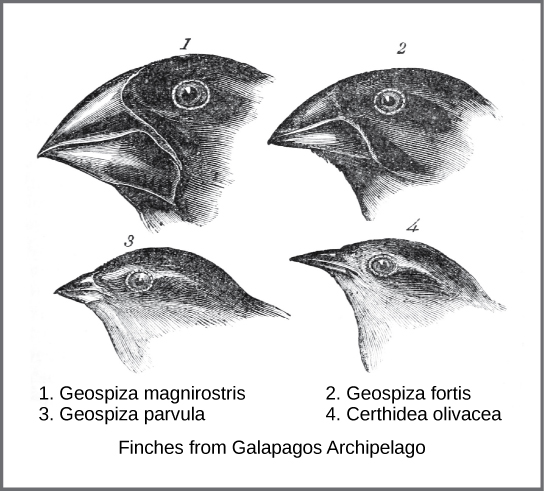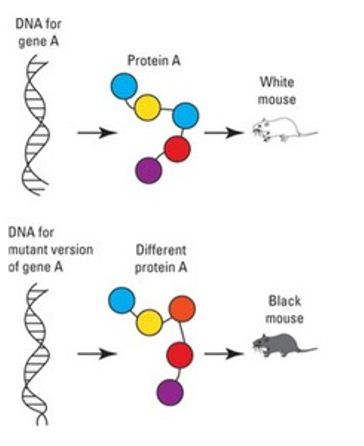Evolution refers to the process that causes changes in allele occurrences in a population over a period. Conferring to Charles Darwin’s theory of evolution, the event takes place by natural selection (Ashraf & Sarfraz, 2016). Thus, evolution enables organisms to acquire characteristics that best suit their environment, increasing their chances of survival and reproduction. Therefore, this essay discusses the four basics of evolution: mutation, genetic drift, natural selection, and gene flow.
Natural Selection
It is the most well-known mechanism of evolution, and it occurs when certain phenotypes confer advantages or disadvantages in survival which is determined by reproductive success. For example, Galapagos finches have developed different beaks (Funk & Burns, 2018). More small seeds are formed during the rainy period, and those fiches with smaller beaks survive better. But during periods of drought, the birds with the larger beaks survive well than those with smaller ones. However, as the environment supports both kinds of beaks, the two species of finches remain in the population.

Mutation
A mutation is an alteration in the genetic sequence of the gene in an organism. It is a basis of novel alleles in a population with a net effect on gene occurrence. The variation in frequency subsequent from mutation is small, making its effects on evolution minor unless it interrelates with factors like selection. However, the mutations that affect the fitness of an organism’s future generation are agents of evolution (Hendry et al., 2018). This is because some types of the mutation positively affect the offspring’s fitness, which results in an adaptation. For example, the diagram below shows a change in the genetic sequence resulting in different proteins being coded for and changing the phenotype of the mouse from having white fur to having black fur.

Genetic Drift
Genetic drift is another way by which allele frequencies of populations change, resulting in evolution. It involves alterations in allele frequency by chance events when choosing alleles for the subsequent generation. Genetic drift in a population can lead to removing an allele from a populace by chance (Slatkin, 2017). The occurrence of alleles in the succeeding generation is equal to that among the individuals reproducing. A certain population can experience a robust effect of genetic drift through a scenario called the bottleneck effect (Shook et al., 2018). It results in a big portion of the gene pool abruptly being wiped out due to natural events like a disaster.
The Gene Flow
It is another important evolutionary force and involves the flow of genes into and out of a population (Fowler et al., 2018) because of either movement of specific organisms or their gametes. Gametes and organisms that move into a population may have different alleles and may bring in existing genes but in varying quantities than those already existing (Fowler et al., 2018). For instance, in plants, the seeds dispersed by wind animals or wind may present genes common in the source populace to a new one in which they are rare.
Conclusion
Four important forces can change the gene frequencies in a populace—the natural selection functions by choosing for alleles that confer advantageous traits while picking against those for harmful qualities. Secondly, genetic drift stems from the chance event that some species have more young ones than others and changes in gene occurrences that are random in trend. Third, mutations introduce new versions of alleles into populations. Finally, the movement of an organism into and out of a population can change gene frequencies due to the gene flow.
References
Ashraf, M. A., & Sarfraz, M. (2016). Biology and evolution of life science. Saudi Journal of Biological Sciences, 23(1), S1.
Fowler, S., Roush, R., & Wise, J. (2018). Concepts of biology. OpenStax.
Funk, E. R., & Burns, K. J. (2018). Biogeographic origins of Darwin’s finches (Thraupidae: Coerebinae). The Auk: Ornithological Advances, 135(3), 561-571.
Hendry, A. P., Schoen, D. J., Wolak, M. E., & Reid, J. M. (2018). The contemporary evolution of fitness. Annual Review of Ecology, Evolution, and Systematics, 49, 457-476.
Shook, B., Nelson, K., Aguilera, K., & Braff, L. (2019). Forces of evolution. Explorations.
Slatkin, M. (2017). Gene flow and population structure. In L. Real (Ed.), Ecological Genetics (pp. 1-17). Princeton University Press.